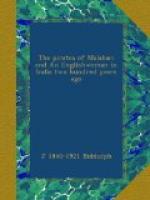“We soon made him yield his prize to engage with us, which they did briskly for two hours, striving to board us, casting stink-pots among us, which broke without any execution, but so frightened our rowers, that we were forced to be severe to restrain them. They plied their chambers and small shot, and slung stones, flourishing their targets and darting long lances. They were well manned in a boat ten times as big as our barge, and at least sixty fighting men besides rowers. We had none to manage our small gun,” the gunner having deserted at Goa.
However, the pirates were beaten off, and Fryer and his companions were mightily praised by the Dutch. These pirates hailed probably from Vingorla, where the Sawunt Waree chief, known in those days as the ’Kempsant,’[2] carried on a brisk piratical trade. The name was a corruption of Khem Sawunt, a common name of the Vingorla chiefs; the Portuguese changed it into Quemar Santo, ‘the saint burner,’ on account of his sacrilegious treatment of their churches.
There were no more determined pirates than the Arabs of Muscat and the Sanganians of Beyt and Dwarka, who, between them, intercepted the trade of the Persian Gulf, while the Coolee rovers of Guzarat took their toll of the plunder. In 1683 the Company’s ship President was attacked by the Muscat Arabs with two ships and four grabs, and fought a gallant action. The grabs[3] were generally two-masted ships, from one hundred and fifty to three hundred tons burden, built to draw very little water, and excellent sailers, especially in the light winds prevalent on the Western coast. They had no bowsprit, but the main-deck was continued into a long overhanging prow. The favourite mode of using them was for two or three of them to run aboard their victim at the same time, and attack, sword in hand, along the prow. Being built for fighting, and not for trade, they could sail round the clumsy merchantmen that hailed from the Thames, and, if pressed, could find safety in the shallow bays and mouths of rivers along the coast. Three grabs grappled the President at once, but the boarders were beaten back, and all three were blown up and sunk, on which the rest of the squadron made off. The President was set on fire in sixteen places, and lost eleven men killed and thirty-three wounded.
In the following year the Josiah ketch was attacked by the Sanganians while at anchor, and in the heat of the engagement blew up. A few of the crew saved themselves in a skiff, but the greater number perished, among them the commander, Lieutenant Pitts, whose father was known in Bombay as ‘the drunken lieutenant.’




